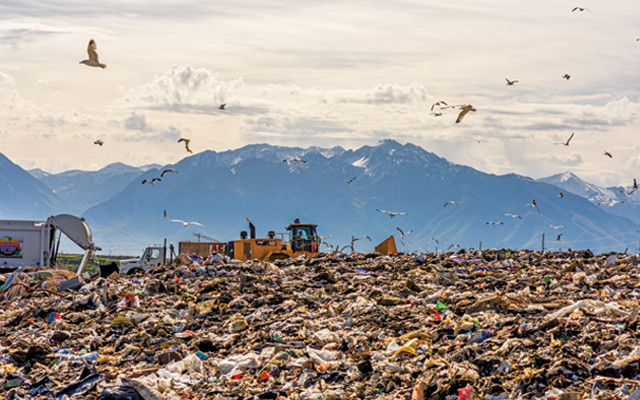
by Mary Caperton Morton Monday, August 24, 2015

Landfills represent a massive source of rare earth materials. Credit: ©Geoff Livingston, CC BY-NC-SA-2.0.
The 17 rare earth elements, widely used in everyday devices from cellphones to magnets and fluorescent lights, aren’t all that rare. They are just finely dispersed in small quantities around the world, making them difficult to mine in substantial quantities. Recycling rare earths is an attractive means to supplement freshly mined stocks, but it remains technically and logistically difficult. Now, a team has developed a more efficient method of recycling two rare earth elements — europium and yttrium — using ultraviolet (UV) light instead of traditional methods involving chemical solvents.
Rare earth recycling is critical for both economic and environmental reasons, says Bart Van den Bogaert, a chemist at the University of Leuven in Belgium and lead author of the new study published in Green Chemistry. “There are very few economically viable sites to mine rare earth elements, and you never find them in pure form,” Van den Bogaert says. And because the deposits are so widely scattered, a lot of ground must be torn up and a lot of energy expended when they are mined, meaning rare earth mining tends to come with a large environmental footprint.
Additionally, stockpiles of used rare earth materials in landfills are massive, Van den Bogaert says. “There’s a lot of waste of rare earth elements. Almost none are efficiently recycled at this time.”
Europium and yttrium are two rare earth metals that are used in fluorescent and energy-efficient light bulbs to create white light. Once the bulbs outlive their usefulness, the two elements can be extracted and recovered from the red lamp phosphor powder with the help of an ionic liquid, or liquefied salt, solvent.
However, “solvent extraction is a time-consuming process,” Van den Bogaert says. “The chemical properties of the elements are very much alike, and it takes hundreds of stages [of processing] to attain the purity needed” in order to reuse the metals.
The new technique uses UV light to separate the two elements from the phosphor mixture and from one another based on the respective photochemical properties of the two metals, which are more distinct than their chemical properties.
The UV light influences the electrical charge on ions of the two elements. “Both europium and yttrium have three positive charges per ion. When we shine UV light upon the solution containing the mixture of europium and yttrium, we add energy to the system,” Van den Bogaert says. “As a result, one positive charge per europium ion is neutralized.” When sulphate is added, only the europium reacts with it, and you get “a precipitate that can easily be filtered, while the yttrium remains in the solution,” he says.
“Our technique is much more selective and can be applied much more efficiently” than solvent extraction, says Van den Bogaert, who developed the technique along with Tom Van Gerven, also of the University of Leuven, and other colleagues. The UV method has been used before to separate other metals like iron and cobalt from one another, but never on rare earth elements in the context of recycling, he says.
The technique is not only more efficient — more than 95 percent of europium is recovered in one step — but also cleaner than the solvent method, he says. “UV light does not leave behind any harmful chemicals,” he says. The team hopes to develop the technique even further, using more energy-efficient light sources, such as LEDs.
Now that the team has shown the technique works, the challenge will be to scale it up to an industrial level, says Ryan Ott, a materials scientist at the U.S. Department of Energy’s Ames Laboratory operated by Iowa State University. “They’ve demonstrated the efficiency of their technique in the lab, but there’s always a gap between what works in the lab and what works on an industrial scale,” he says. The team will likely face not just technical difficulties, but also logistical hurdles, such as gathering used light bulbs on a large scale.
“Certain recycling industries are very established, like aluminum and steel, but rare earth recycling is still in its infancy,” Ott says. Infrastructure and centralized collection facilities, for example, are lacking. “It’s not like plastic recycling, where the different types of bottles have a number stamped on them and you can toss them in the right bin,” he says. “Organization is a large part of the rare earth-recycling problem right now.”
© 2008-2021. All rights reserved. Any copying, redistribution or retransmission of any of the contents of this service without the expressed written permission of the American Geosciences Institute is expressly prohibited. Click here for all copyright requests.